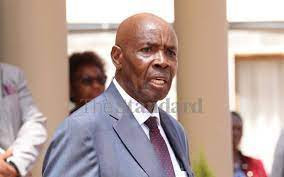By Frankline Sunday
Kenya: Kenya does not want to produce from its educational institutions graduates who will be like robot machines but disciplined youth with a sense of service to the country. This was the message from retired President Daniel Moi, the then vice-President on this day, 40 years ago.
Moi, who had been a teacher himself for more than a decade before taking politics as a career, was an ardent crusader of education as a tool for the young republic to pull its masses out of ignorance and poverty.
Speaking at Equator Girls Secondary School in Kieni, Moi stressed that alongside education, a good religious background and a strong sense of discipline were important in realising a wholly trained and educated individual.
On the same day in Nairobi, the Nairobi City Council revealed that the increasing number of pupils graduating from primary schools meant that the council had to build more secondary schools to meet the growing demand.
A letter from the Nairobi Provincial Educational officer at the time, indicated cases of rural-urban migration, which were high at the time, had led to an increase in the number of children joining schools in the city.
“Nairobi as a capital city and the economic hub of the country has to consider the educational needs not only of children living in it but of the children who followed their relatives to the city,” read part of the letter.
In early post-independent Kenya, the Kenyan education system was composed of three main categories of schools; private, public and harambee schools.
While public and private schools continue to exist in their basic traditional structure of administration and financing, harambee schools have in largely fizzled out and few Kenyans who went to school after the 1980s can remember them.
Former Assistant Minister for Education Prof Kilemi Mwiria, in a 1990 study dubbed Kenya’s Harambee Secondary School Movement; The Contradictions of Public Policy, highlights some of the factors that led to the rise and fall of the harambee school system.
In the study, Prof Mwiria states that in the early post-independence days of the Harambee movement, religious organisations eager to stamp their influence in the local communities took advantage of the hunger for formal education.
By the late 1960s, the harambee school movement had assumed a distinctively political character as local politicians keen to integrate themselves to their constituents begun to play a pivotal role in the establishment of new schools and supporting the existing ones.
Sponsorship
Since then, the success or failure of harambee schools has depended not on the sponsorship of church groups but on the ability of local politicians and leaders to attract local or foreign funding.
With the rapidly changing political landscape of the 1970s and 1980s, harambee schools in many parts of the country became a victim of circumstance as politicians lost their seats or donor partners withdrew funding to a questionable regime.
Stay informed. Subscribe to our newsletter
While some form of community-funded schools continues to exist in parts of Kenya’s rural areas and informal settlements, the problem in Kenya’s education sector that this form of school system sought to address still exists.
content models
Fast forward 30 years later and Kenya’s educational system is handicapped by various challenges with the financing, administrative and content models coming under sharp focus.
Data from the Ministry of Education indicates that Kenya’s literacy level is about 70 per cent with a low secondary education net enrolment of only 32 per cent and only one in six adults aged 15-64 years said to have attained secondary school education.
While the free primary education policy put in place ten years ago realised an increase in the number of enrolments, the content and quality of education was not addressed.
The result was a degradation of public education as the high number of students against few un-motivated teachers led to low levels of teacher-student interaction and delivery of educational content largely suffered.
In addition to this, there remains a huge gap between public schools and private academies both in the primary and secondary level.
Students in public schools who mostly come from middle to low-income households have significantly less learning resources compared to their counterparts in private schools who are mostly from affluent households.
The result has been a cyclical and widening gap in the quality of living between the rich and the poor. As students from rich households get the best of secondary and tertiary education, their chances of getting well-paying jobs and a head start are magnified compared to their counterparts from poor and low-income households.
Bridging this gap in the country’s education sector should be the single most important priority to the current and future education policy makers and will go a long way to reduce poverty and inequality in the long-term.
 The Standard Group Plc is a
multi-media organization with investments in media platforms spanning newspaper
print operations, television, radio broadcasting, digital and online services. The
Standard Group is recognized as a leading multi-media house in Kenya with a key
influence in matters of national and international interest.
The Standard Group Plc is a
multi-media organization with investments in media platforms spanning newspaper
print operations, television, radio broadcasting, digital and online services. The
Standard Group is recognized as a leading multi-media house in Kenya with a key
influence in matters of national and international interest.
 The Standard Group Plc is a
multi-media organization with investments in media platforms spanning newspaper
print operations, television, radio broadcasting, digital and online services. The
Standard Group is recognized as a leading multi-media house in Kenya with a key
influence in matters of national and international interest.
The Standard Group Plc is a
multi-media organization with investments in media platforms spanning newspaper
print operations, television, radio broadcasting, digital and online services. The
Standard Group is recognized as a leading multi-media house in Kenya with a key
influence in matters of national and international interest.









